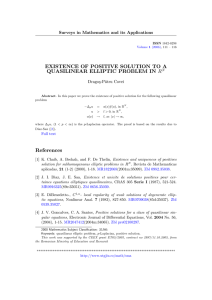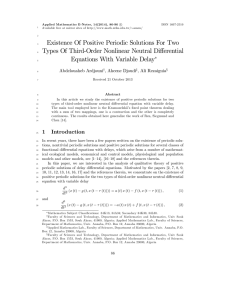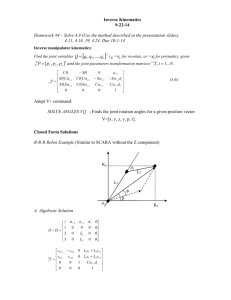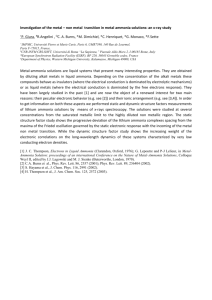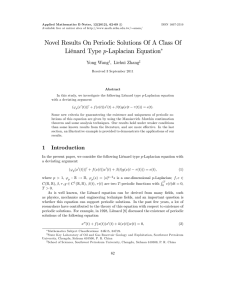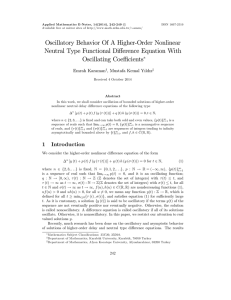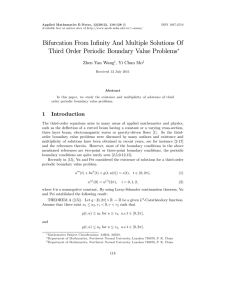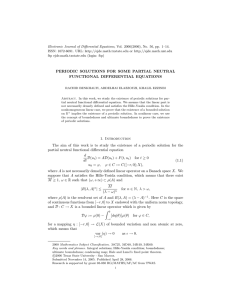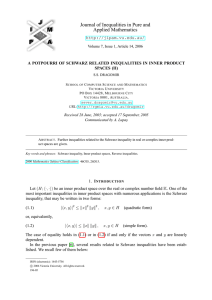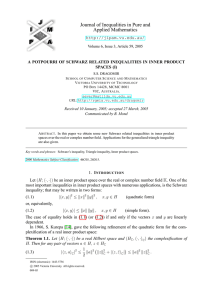Document 10677464
advertisement
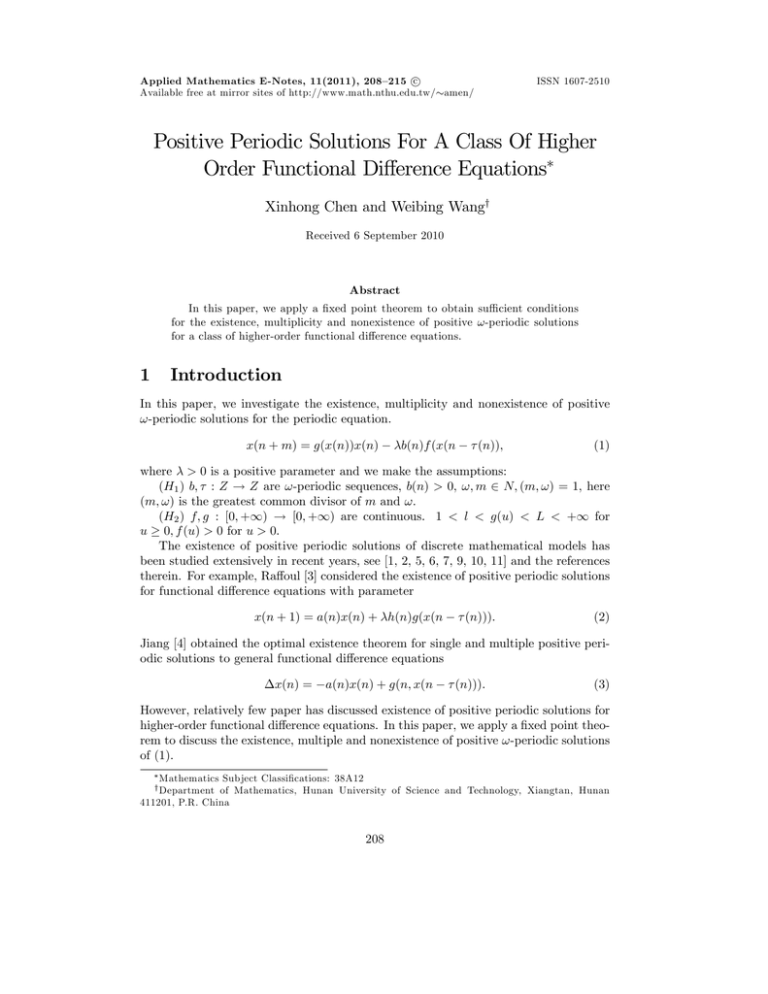
Applied Mathematics E-Notes, 11(2011), 208–215 c Available free at mirror sites of http://www.math.nthu.edu.tw/ amen/ ISSN 1607-2510 Positive Periodic Solutions For A Class Of Higher Order Functional Di¤erence Equations Xinhong Chen and Weibing Wangy Received 6 September 2010 Abstract In this paper, we apply a …xed point theorem to obtain su¢ cient conditions for the existence, multiplicity and nonexistence of positive !-periodic solutions for a class of higher-order functional di¤erence equations. 1 Introduction In this paper, we investigate the existence, multiplicity and nonexistence of positive !-periodic solutions for the periodic equation. x(n + m) = g(x(n))x(n) b(n)f (x(n (n)); (1) where > 0 is a positive parameter and we make the assumptions: (H1 ) b; : Z ! Z are !-periodic sequences, b(n) > 0, !; m 2 N; (m; !) = 1, here (m; !) is the greatest common divisor of m and !. (H2 ) f; g : [0; +1) ! [0; +1) are continuous. 1 < l < g(u) < L < +1 for u 0; f (u) > 0 for u > 0. The existence of positive periodic solutions of discrete mathematical models has been studied extensively in recent years, see [1, 2, 5, 6, 7, 9, 10, 11] and the references therein. For example, Ra¤oul [3] considered the existence of positive periodic solutions for functional di¤erence equations with parameter x(n + 1) = a(n)x(n) + h(n)g(x(n (n))): (2) Jiang [4] obtained the optimal existence theorem for single and multiple positive periodic solutions to general functional di¤erence equations x(n) = a(n)x(n) + g(n; x(n (n))): (3) However, relatively few paper has discussed existence of positive periodic solutions for higher-order functional di¤erence equations. In this paper, we apply a …xed point theorem to discuss the existence, multiple and nonexistence of positive !-periodic solutions of (1). Mathematics Subject Classi…cations: 38A12 of Mathematics, Hunan University of Science and Technology, Xiangtan, Hunan 411201, P.R. China y Department 208 X. H. Chen and W. B. Wang 2 209 Preliminaries Let X = fx : Z ! R; x(n + !) = x(n)g: When endowed with the maximum norm kxk = maxn2[0;!] jx(n)j, X is a Banach space. From (1), we have that for any x 2 X, 1 x(n + m) g(x(n)) b(n) f (x(n g(x(n)) x(n) = (n))); 1 1 x(n + 2m) x(n + m) g(x(n))g(x(n + m)) g(x(n)) b(n + m) f (x(n + m (n + m))); g(x(n))g(x(n + m)) = :::::: ! Y1 ( i=0 = ! Y2 1 )x(n + !m) g(x(n + im)) ! Y1 ( i=0 ( i=0 1 )b(n + (! g(x(n + im)) 1 )x(n + (! g(x(n + im)) 1)m)f (x(n + (! 1)m 1)m) (n + (! 1)m))): By summing the above equations and using periodicity of x, we obtain x(n) = ! X1 i=0 1 Qi 1 j=0 g(x(n+jm)) 1 1 t=0 g(x(n+tm)) Q! b(n + im)f (x(n + im (n + im))): De…ne the map T : X ! X and a cone P in X by ! X1 T x(n) = G(n; i)b(n + im)f (x(n + im (n + im))); i=0 P = fx 2 X : x(n) kxk; n 2 [0; !]g; respectively, where 0 and 1 1 A 1 G(n; i) = @ g(x(n + jm)) j=0 i Y = Clearly, l! L! ! Y1 t=0 1 g(x(n + tm)) 1 : 1 2 (0; 1) and 1 L! 1 G(n; i) 1 l! 1 ;0 i ! 1: ! 1 ; (4) 210 Periodic Solutions of Di¤erence Equations Further, one can easily show that the …xed point of T in P is the positive periodic solution of (1). The following well-known result of the …xed point theorem is crucial in our arguments. LEMMA 2.1 ([8]). Let E be a Banach space and P be a cone in E. Suppose and 2 are open subsets of E such that 0 2 1 1 2 and suppose that T :P \( 2n 1) 1 !P is a completely continuous operator. If one of the following conditions is satis…ed, (i) kT xk kxk for x 2 P \ @ 1 ; kT xk kxk for x 2 P \ @ 2; (ii) kT xk kxk for x 2 P \ @ 1 ; kT xk kxk for x 2 P \ @ 2: Then T has a …xed point in P \ ( 2 n 1 ). LEMMA 2.2. Assume (H1 )-(H2 ) hold. Then T (P ) completely continuous. P and T : P ! P is PROOF. In view of the de…nition of P , for x 2 P , we have T x(n + !) = ! X1 G(n + !; i)b(n + ! + im)f (x(n + ! + im (n + ! + im))) i=0 = ! X1 G(n; i)b(n + im)f (x(n + im (n + im))) = T x(n): i=0 On the other hand, 1 T x(n) L! = = 1 1 L! 1 1 L! 1 ! X1 b(n + im)f (x(n + im (n + im))) i=0 ! X1 b(jm)f (x(jm (jm))) j=0 ! X1 b(j)f (x(j (j))); j=0 and T x(n) Hence, T x(n) 1 l! 1 l! L! ! X1 b(j)f (x(j (j))): j=0 1 kT xk = kT xk: 1 Thus T (P ) P and according to Arzela-Ascoli’s Theorem, it is easy to show that T : P ! P is completely continuous. The proof is complete. X. H. Chen and W. B. Wang 211 LEMMA 2.3. Assume (H1 )-(H2 ) hold and let " > 0. If f (u) then for any x 2 P , ! 1 l! 1 X b(j)kxk: kT xk " ! (L 1)2 j=0 PROOF. Since x 2 P and f (u) 1 T x(n) L! 1 1 L! 1 1 L! = 1 u" for any u > 0, u", we have ! X1 b(n + im)f (x(n + im (n + im))) i=0 ! X1 b(n + im)x(n + im (n + im))" i=0 ! X1 b(j) j=0 l! L! 1 kxk" 1 ! X1 1 b(j)kxk": 1)2 j=0 l! (L! Thus kT xk " ! 1 1 X b(j)kxk: 1)2 j=0 l! (L! LEMMA 2.4. Assume (H1 )-(H2 ) hold . If there exists an for any u > 0 , then for x 2 P kT xk 1 l! 1 ! X1 > 0 such that f (u) u b(j)kxk: j=0 This Lemma can be shown in a similar manner as in Lemma 2.3. 3 Main Results Let r = fx 2 P : kxk < rg: Then @ f0 = lim+ u!0 r = fx 2 P : kxk = rg: Put f (u) f (u) ; f1 = lim ; u!1 u u (5) I0 = number of zeros in the setff0 ; f1 g; I1 = number of in…nitions in the setff0 ; f1 g; m(r) = minff (x) : x 2 [ r; r]; r > 0g; M (r) = maxff (x) : x 2 [ r; r]; r > 0g: At …rst, we discuss the existence and multiplicity of positive periodic solutions for (1). 212 Periodic Solutions of Di¤erence Equations THEOREM 3.1. Assume (H1 )-(H2 ) hold. If I0 = 1 or 2, then (1) has at least one I0 positive !-periodic solution for > where r L! 1 inf : = P! 1 r>0 m(r) j=0 b(j) PROOF. Choose r1 > 0 such that P! 1 j=0 L! r r1 inf < r>0 m(r) m(r1 ) Noting that f (u) b(j) 1 m(r1 ) for u 2 @ r1 , we can easily get P! 1 j=0 b(j)m(r1 ) kT xk ;x 2 @ L! 1 : r1 : Hence, kT xk > kxk; for x 2 @ r1 and > : If f0 = 0, we choose 0 < r2 < r1 such that f (x) x for 0 satis…es ! 1 1 X b(j) < 1: l! 1 j=0 According to Lemma 2.4, we have for x 2 @ l! 1 r2 , where >0 r2 , ! X1 1 kT xk x b(j)kxk j=0 kxk: Then T has a …xed point in P \ ( r1 n r2 ), which is a positive !-periodic solution of (1) for > : If f1 = 0, there is a K > 0 such that f (x) x for x K, where > 0 satis…es 1 l! 1 ! X1 b(j) < 1: j=0 Let r3 = maxf2r1 ; K g, then x(n) kxk K for x 2 @ f (x) x for x 2 @ r3 . In view of Lemma 2.4, we have kT xk 1 l! 1 ! X1 j=0 b(j)kxk r3 kxk; for x 2 @ and n 2 [0; !]: Thus r3 : Then T has a …xed point in P \( r3 n r1 ), and (1) has at least one positive !-periodic solution for > . If f0 = f1 = 0, it is easy to see from the above proof that T has a …xed point x1 in r1 n r2 and a …xed point x2 in r3 n r1 such that r2 < kx1 k < r1 < kx2 k < r3 : X. H. Chen and W. B. Wang 213 Consequently, (1) has at least two positive !-periodic solutions for > : The proof is complete. Similar to that of the Theorem 3.1, we have THEOREM 3.2. Assume (H1 )-(H2 ) hold. If I1 = 1 or 2, then (1) has at least one ! I1 positive !-periodic solution for 0 < < P!l 1 1b(j) supr>0 Mr(r) : j=0 Next, we consider the nonexistence of positive !-periodic solutions for (1). THEOREM 3.3. Assume (H1 )-(H2 ) hold. If I0 = 0 (or I1 = 0), then (1) has no positive !-periodic solutions for su¢ ciently large > 0 (or su¢ ciently small > 0). PROOF. Since I0 = 0, we have f0 > 0 and f1 > 0, there exist "1 > 0; "2 > 0 and > 2 1 > 0 such that f (x) "1 x for x 2 [0; 1 ]; f (x) "2 x for x 2 [ Let c1 = min "1 ; "2 ; min 1 x 2 f 2 ; 1): f (x) g : x Then f (x) c1 x for x 2 [0; 1): Assume y is a positive !-periodic solution of (1). We show that this leads to a contradiction for > ; where = (L! (l! 1)c1 1)2 P! 1 j=0 b(j) Since T y = y; it follows from Lemma 2.3 that for kyk = kT yk : > ; ! 1 X 1 c1 b(j)kyk > kyk; 2 1) j=0 l! (L! which is a contradiction. If I1 = 0; then f0 < 1 andf1 < 1: There exists 1 > 0; 2 > 0; 2 > that f (x) f (x) 1 x for x 2 [0; 1 ]; 2 x for x 2 [ 2 ; 1): Let c2 = maxf 1 ; f (x) 2 ; maxf x gg; f (x) 1 > 0 such we have c2 x for x 2 [0; 1): Assume y is a positive !-periodic solution of (1). We show that this leads to a contradiction for 0 < < ; where l! 1 = P! 1 : c2 j=0 b(j) Since T y = y, it follows from Lemma 2.4 that for 0 < kyk = kT yk 1 l! 1 c2 ! X1 j=0 < ; b(j)kyk < kyk; 214 Periodic Solutions of Di¤erence Equations which is a contradiction. The proof is complete. COROLLARY 3.1. Assume that (H1 )-(H2 ) hold. If there is a M1 > 0 such that ! 2 f (x) M1 x for x 2 [0; 1), then there exists a = (l! 1)(LP! 1)1 b(j)M such that for all 1 j=0 > , (1) has no positive !-periodic solution. COROLLARY 3.2. Assume that (H1 )-(H2 ) hold. If there is a M2 > 0 such that ! 1 f (x) M2 x for x 2 [0; 1), then there exists a = P! l 1 b(j)M such that for all 2 j=0 0< < , (1) has no positive !-periodic solutions. 4 Examples In this section, we illustrate our main results obtained in the previous sections with several examples. EXAMPLE 4.1. Consider the di¤erence equation x(n + 3) = (3 + sin x(n))x(n) b(n)x3 (n 9); (6) here b(n) > 0 is a 4-periodic sequences, In fact 2 3 + sin(x(n)) 4 for n 2 [0; 4]. f (u) = u3 and f0 = lim+ u!0 f (u) f (u) = 0; f1 = lim = 1: u!1 u u By Theorems 3.1 and 3.2, (6) has at least one positive !-periodic solution for su¢ ciently large > 0 or su¢ ciently small > 0. EXAMPLE 4.2. Consider the di¤erence equation x(n + 1) = 3x(n) sin x(n) b(n)x(n (n)); (7) here b(n) > 0 and : Z ! Z are !-periodic sequences. Clearly, the positive periodic solutions of (7) are the positive periodic solutions of the following di¤erence equation x(n + 1) = g(x(n))x(n) where g(u) = 3 2; sin u u ; b(n)x(n (n)); (8) if u > 0; if u = 0: Note that f (u) f (u) = 1; f1 = lim = 1: u!1 u u By Theorem 3.3, (8) has no positive !-periodic solutions for su¢ ciently large or small > 0. Hence, (7) has no positive !-periodic solutions for su¢ ciently large or small > 0. f0 = lim+ u!0 Acknowledgement. Supported by the Scienti…c Research Fund of Hunan Provincial Education Department (09B033) and by Hunan Provincial Natural Science Foundation of China (09JJ3010). X. H. Chen and W. B. Wang 215 References [1] L. Rachunek and I. Rachunkova, Strictly increasing solutions of nonautonomous di¤erence equations arising in hydrodynamics, Advances in Di¤erence Equations, Vol. 2010(2010), Article ID 714891, 11 pages. [2] X. Liu and Y. Liu, On positive periodic solutions of functional di¤erence equations with forcing term and applications, Computers and Mathematics with Applications, 56(9)(2008), 2247–2255. [3] Y. N. Ra¤oul, Positive periodic solutions of nonlinear functional di¤erence equations, Electron. J. Di¤erential Equations, 55(2002), 1–8. [4] D. Jiang, D. O’Regan and R. P. Agarwal, Optimal existence theory for single and multiple positive periodic solutions to functional di¤erence equations, Appl. Math. Comput., 161(2)(2005), 441–462. [5] Y. Li and L. Zhu, Existence of positive periodic solutions for di¤erence equations with feedback control, Appl. Math. Lett., 18(1)(2005), 61–67. [6] L. Berezansky and E. Braverman, On existence of positive solutions for linear di¤erence equations with several delays, Advances in Dynamical Systems and Applications, 1(2006), 29–47. [7] Z. Zeng, Existence of positive periodic solutions for a class of nonautonomous di¤erence equations, Electron J. Di¤erential Equations, Vol. 2006(2006), 1-18. [8] D. Guo and V. Lakshmikantham, Nonlinear Problems in Abstract Cones, Academic Press, New York, 1988. [9] P. W. Eloe, Y. Ra¤oul, D. Reid and K. Yin, Positive solutions of nonlinear functional di¤erence equations, Computers and Mathematics With applications, 42(2001), 639–646. [10] J. Henderson and S. Lauer, Existence of a positive solution for an n-th order boundary value problem for nonlinear di¤erence equations, Applied and Abstract Analysis, 1(1997), 271–279. [11] M. Ma and J. Yu, Existence of multiple positive periodic solutions for nonlinear functional di¤erence equations, Journal of Mathematical Analysis and Applications. 305(2)(2005), 483–490.

